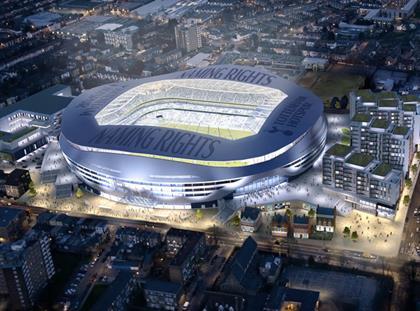Local residents are fighting back against the gentrification led by Tottenham Hotspur's stadium redevelopment plans. Spurs fan Joel Sharples looks at how the club has let down the community it is supposedly a part of.
The recent protest movement in Brazil has
drawn the world’s attention to the way in which sport-led development can act
to disenfranchise, uproot and divert funding away from low-income communities.
Less attention, however, has been given to the strikingly similar dynamics at
work on a smaller scale in North London, where residents of Tottenham are
facing eviction from their homes as a result of Tottenham Hotspur Football
Club’s stadium redevelopment plans. The #AgainstModernFootball concept is
gaining traction at the moment and perhaps this is emblematic of why – football
clubs are now not just disconnected from the communities that they are a part
of; they are actively contributing to the destruction of those communities.
You might have thought that the 11th richest
club in the world that stands to make windfall
gains of over £100m over the next three years from the new TV revenue deal
might be able to dredge up the additional £5m that is supposedly needed to
release private investment for the new stadium. Instead they are turning to
Haringey council, who intend to raise the £5m through the sale of the Love
Lane/Whitehall Street estate, which sits between White Hart Lane station and
the stadium. This could lead to the demolition
of nearly 300 council homes, with residents being kept in the dark about
whether they will be found suitable accommodation in the area. Given that
Haringey has one of the longest council housing waiting lists in the country,
with 10%
of all households in the borough on the list, it is highly unlikely that
they will.
Spurs have played their cards well with the
council in recent years, using the threat of exodus to the Olympic Stadium in
Stratford to squeeze ever-greater amounts of public subsidy from Haringey
Council and the Greater London Authority. In 2011 the council leader Claire
Kober stated that no public money would go into the development and Spurs would
provide £15-16m in Section 106 funding to redevelop the local area. Nine months
later a £17m
public funding package was on the table and by January 2012 this was raised
to £41.3m with almost all of Spurs’s S106 obligations dropped. Ironically,
this is almost exactly the sum that Spurs challenged in the
courts as illegal “state aid” when it was offered by Newham Council to West
Ham to develop the Olympic Stadium.
Perhaps most cynical, and audacious, is how
they tapped into £8.5 million of the £50 million set aside by Boris Johnson to
develop areas affected by the August 2011 riots. In doing so, they have
effectively cashed in on the social unrest in Tottenham to fund a stadium that
will provide huge profits for shareholders and little if any benefit to the
surrounding community. The money will essentially go towards funding the
improvements to infrastructure surrounding the stadium that Spurs would
have had to provide anyway to cope with the extra 20,000-odd fans travelling
to the area on match days.
But what is most concerning for local
residents is how THFC has shirked its responsibility to provide affordable housing
at the same time as it is destroying existing council-owned homes. In its
initial plans Spurs had an obligation to provide 100
affordable homes alongside 100 to be sold on the open market. This in
itself was pitifully low given the housing crisis in Haringey, but in 2012 the
council responded to Spurs’s blackmailing by waiving this requirement as well
as the £1.2 million that had been promised to improve local schools. Instead
the club has been allowed to build 285 homes that will be sold at market rates.
These will be overwhelmingly one and two bedroom flats that will no doubt be
snapped up by City workers enjoying the improved overground links to central
London, also paid for with public money. This will contribute to pushing up
rents in the area which, combined with the benefits cap which has been
introduced in Haringey, could force large numbers of low-income families out of
their homes.
As a lifelong Spurs fan the slow
realization that the club I love is no different to any other large corporation
in its parasitism and disrespect for community life has been a painful one.
However, as stakeholders in the club and potential punters at the new stadium,
I think fans have a responsibility to show solidarity with those who will be
affected and potentially displaced by the new development.
Local residents and traders have been
mobilising to resist the current wave of gentrification that is sweeping
through Tottenham, driven by the stadium redevelopment plans. Our Tottenham are
organising a street
assembly this Saturday 6th July to say no to the threat of
evictions, high rents and loss of community services and demand the
improvements that the neighbourhood actually needs.
Follow Joel on Twitter: @JoelJBSharples



Fantastic work Joel. As a gooner myself it's a real worry to see this happening to the local community of our beloved clubs. They are there FOR the community, not to damage or work against it. Really hope the media give this the coverage it deserves. I've linked it to several journo's on twitter already.
ReplyDeleteall the best.
Muhammad
Nice article. Bears strikinig similarities to the methods employed by Liverpool, and I'm sure many other football clubs round the world. Unfortunately the only way to fight it is by not handing the club any of your hard-earned money, and to hope your fellow supporters take the same stance. But in this global age, our PL clubs don't really need to worry about their local fan-base anymore, they're far more concerned with how many shirts they sold in China last year.
ReplyDelete